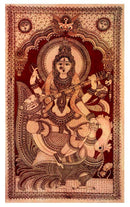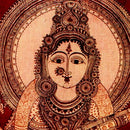The beautiful Kalamkari painting depicts the goddess of learning Saraswati on her vehicle the swan. She is a goddess worshipped in the Vedic religion. She is the goddess of learning and the arts (e.g., music). She is also worshipped as the goddess of thoughts of truth and forgiveness. She is also referred to as the goddess of knowledge, speech, poetry and music. Vedantins believe that only through the acquisition of knowledge does one reach the final path to moksha, or liberation from reincarnation. Only by worshiping Saraswati and continuously seeking true knowledge with one's complete attention can one attain the enlightenment necessary for moksha.
The painting of goddess Saraswati is depicted as a beautiful, fair-skinned woman dressed in pure white often seated on a white lotus along with the swan, which symbolizes that she is founded in the experience of the Absolute Truth. Thus, she not only has the knowledge but also the experience of the Highest Reality. She is mainly associated with the color white, which signifies the purity of true knowledge. Occasionally, however, she is also associated with the colour yellow, the colour of the flowers of the mustard plant that bloom at the time of her festival in the spring. She is not adorned heavily with jewels and gold, unlike the goddess Lakshmi, but is dressed modestly--perhaps representing her preference of knowledge over worldly material things.
She is generally shown to have four arms, which represent the four aspects of human personality in learning: mind, intellect, alertness, and ego. She is shown to hold the following in her hands:
The book, the sacred Vedas, represents the universal, divine, eternal, and true knowledge as well as her perfection of the sciences and the scriptures. The mala of white pearls, represents the power of meditation and spirituality. The pot of sacred water, represents creative and purificatory powers.
The veena, a musical instrument that represents her perfection of all arts and sciences. Saraswati is also associated with Anurag, the love for and rhythm of music which represents all emotions and feelings expressed in speech or music. It is believed that children born with that name will prove to be very lucky in their studies.
A white swan is often located next to her feet. The sacred swan, if offered a mixture of milk and water, is said to be able to drink the milk alone. The swan thus symbolizes discrimination between the good and the bad or the eternal and the evanescent. Due to her association with the swan, Goddess Saraswati is also referred to as Hamsa-vahini, which means "she who has a swan as her vehicle".
She is usually depicted near a flowing river, which may be related to her early history as a water goddess. The swan and her association with the lotus flower also point to her ancient origin.
Sometimes a peacock is shown beside the goddess. The peacock represents arrogance and pride over its beauty, and by having a peacock as her mount, the Goddess teaches Hindus not to be concerned with external appearance and to be wise regarding the eternal truth.
Description
The beautiful Kalamkari painting depicts the goddess of learning Saraswati on her vehicle the swan. She is a goddess worshipped in the Vedic religion. She is the goddess of learning and the arts (e.g., music). She is also worshipped as the goddess of thoughts of truth and forgiveness. She is also referred to as the goddess of knowledge, speech, poetry and music. Vedantins believe that only through the acquisition of knowledge does one reach the final path to moksha, or liberation from reincarnation. Only by worshiping Saraswati and continuously seeking true knowledge with one's complete attention can one attain the enlightenment necessary for moksha.
The painting of goddess Saraswati is depicted as a beautiful, fair-skinned woman dressed in pure white often seated on a white lotus along with the swan, which symbolizes that she is founded in the experience of the Absolute Truth. Thus, she not only has the knowledge but also the experience of the Highest Reality. She is mainly associated with the color white, which signifies the purity of true knowledge. Occasionally, however, she is also associated with the colour yellow, the colour of the flowers of the mustard plant that bloom at the time of her festival in the spring. She is not adorned heavily with jewels and gold, unlike the goddess Lakshmi, but is dressed modestly--perhaps representing her preference of knowledge over worldly material things.
She is generally shown to have four arms, which represent the four aspects of human personality in learning: mind, intellect, alertness, and ego. She is shown to hold the following in her hands:
The book, the sacred Vedas, represents the universal, divine, eternal, and true knowledge as well as her perfection of the sciences and the scriptures. The mala of white pearls, represents the power of meditation and spirituality. The pot of sacred water, represents creative and purificatory powers.
The veena, a musical instrument that represents her perfection of all arts and sciences. Saraswati is also associated with Anurag, the love for and rhythm of music which represents all emotions and feelings expressed in speech or music. It is believed that children born with that name will prove to be very lucky in their studies.
A white swan is often located next to her feet. The sacred swan, if offered a mixture of milk and water, is said to be able to drink the milk alone. The swan thus symbolizes discrimination between the good and the bad or the eternal and the evanescent. Due to her association with the swan, Goddess Saraswati is also referred to as Hamsa-vahini, which means "she who has a swan as her vehicle".
She is usually depicted near a flowing river, which may be related to her early history as a water goddess. The swan and her association with the lotus flower also point to her ancient origin.
Sometimes a peacock is shown beside the goddess. The peacock represents arrogance and pride over its beauty, and by having a peacock as her mount, the Goddess teaches Hindus not to be concerned with external appearance and to be wise regarding the eternal truth.
Payment & Security
Your payment information is processed securely. We do not store credit card details nor have access to your credit card information.




